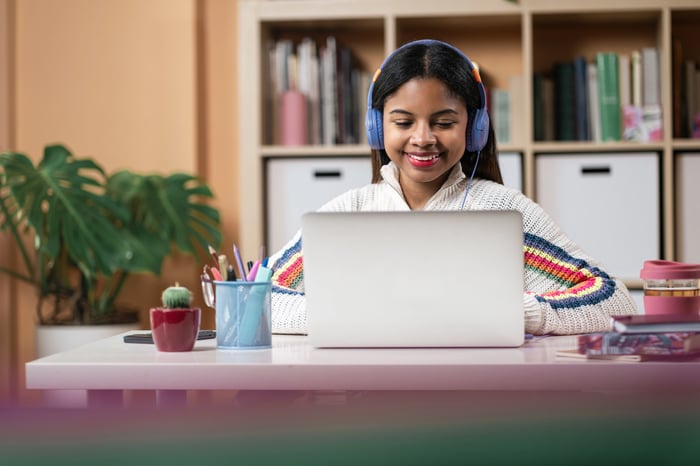In 2014, the Australian government committed to reaching AA standards of the Web Content...
How to create engaging online and at-home learning activities
As schools are switching to online instruction to avoid disruption to students’ education, teachers are looking for engaging at-home learning activities and workable and practical solutions to deliver their lessons online.
Monash’s Erin Leif and Bianca Raby from Oppida share how to design active and adaptable lessons that are well suited to online learning.

With the coronavirus pandemic at our doorstep, teachers around the world are being asked to rapidly rethink the way they teach. Many schools are switching to online instruction to ensure students can continue to access education during periods of social isolation and lockdowns. The Victorian Education Minister James Merlino announced on April 7th that term 2 will be online for Victorian students. We understand that this task may be overwhelming for teachers and school leaders, who likely need to come up with workable and practical solutions in a short amount of time.
Synchronous vs asynchronous online learning
It’s important for teachers to understand the difference between synchronous and asynchronous online learning.
Synchronous online learning
Synchronous online learning occurs in real time, with both the teacher and students logged in and online at the same time. This allows the teacher to interact with the students in a shared virtual space. Methods of synchronous online learning include video conferencing, teleconferencing, live chatting, and live-streaming of lessons and lectures.
Asynchronous online learning
Asynchronous online learning occurs on the students own time, in the absence of the teacher. The teacher will provide instructions, learning activities, readings or materials, but then students are responsible for completing the task ‘outside of the classroom.’ Methods of asynchronous online learning include self-guided lesson modules, streaming video content, virtual libraries, posted lesson notes and exchanges across discussion boards or social media platforms.
How long should a session be?
Students may have difficulty attending long periods of instructional time in a typical face-to-face classroom, let alone in front of a computer screen! Therefore, our recommendation is for teachers to conduct short periods of synchronous online instruction (no more than 30 minutes at a time), interspersed with a variety of asynchronous but guided learning activities. Afterall, can you imagine trying to manage your students behaviour and attention online for over 30 minutes?
Tips for transitioning to online learning
Here, we provide an overview of how to design active and adaptable lessons that are well suited to online learning. These tips allow you to include a combination of synchronous and asynchronous learning activities, and are designed to maximise student engagement and real-life application!
Encourage students to be active participants
To help with engagement, when designing online instruction, it is critical for teachers to create active learning activities and experiences for students, with the teacher taking on the role of facilitator, rather than ‘lecturer’.
Conrad and Donaldson (2011) recommend that:
- students play a role in developing their own learning goals,
- students work together in groups,
- students explore appropriate resources to answer meaningful questions,
- students complete tasks that are multidisciplinary and authentic, with connections to the real world,
- students receive ongoing, performance-based feedback,
- students create products that can be shared within and beyond the classroom.
Start with the content that your students are already familiar with
Rapidly transitioning to online teaching is a challenging thing to do. You and your students might be unfamiliar with the new technology you are being asked to use, and may not have all the materials needed to present and engage with new content. For this reason, we recommend initially designing lessons and learning activities that allow your students to engage with familiar content in a new way, rather than presenting new content. This will reduce the chance of cognitive overload and give students the opportunity to revise!
Once you are all familiar with the new delivery mode, then try expanding to new content and curriculum objectives.
Example:
Let’s say earlier in the year, you covered topics related to health, international relations, politics, or government. Now might be the time to help your students relate this content to what is currently happening in the world. Your lesson could involve teaching students about the World Health Organisation (WHO) and how it supports countries to promote the health and well-being of people around the world.
Adopt ‘flipped classroom’ model of delivery
We recommend using a ‘flipped classroom’ model when delivering online instruction. With a flipped classroom, you have the students complete a learning activity before interacting with the teacher synchronously. By completing the activity before coming to the lesson, your students can come prepared with questions, progress updates, or maybe even a brief presentation. This will allow them to be more actively engaged during the synchronous instruction.
Step 1: Design the asynchronous learning activities
These are the tasks that students will complete on their own. Because you will not be there to answer questions, it is important to provide detailed and clear instructions to your students.
Example:
Ask your students to research the World Health Organisation, and to send in three interesting facts one hour before the lesson.
Step 2: Design the synchronous learning activities
This is where you will see your students online, in real time. You should plan to deliver the synchronous instruction in blocks that are no more than 30 minutes! Because students have engaged with the material before attending the synchronous instruction (for example, reviewing the instructions for an activity, completing learning activities, or reading), you can use this time to answer student questions or allow students to present components of their completed work to the class.
Example:
Now that your students have sent in their facts about the WHO, you can collate and present the information provided by the students and open up for discussion. Pair the students (using breakout rooms) and ask them to come up with two questions they would ask a senior official working for the WHO. Bring them back to the main room and provide an opportunity for them to share.
Design assessment with online technologies in mind
During the design phase of the lesson, think about what you may like to assess (either formative or summative) and use the technology (if possible) to do this. You may also want to get your students involved in the delivery of formative feedback. You might ask them to swap completed learning activities with each other, and provide feedback to one another using a rubric or a guide created by you. This may have the added benefit of helping your students stay connected to one another.
Example:
Following on from the activity above, ask your student pairs to submit their two questions for formative assessment, and have it ‘peer marked’ by another pair of students (using a small rubric provided by you).
Make communicating with parents a part of your daily routine
Many parents may be particularly anxious during this time, and may look to you for guidance on how to keep their kids on track with their learning at home. We recommend allocating some time into your schedule every day for the sole purpose of communicating with parents. You might block out a time each day to respond to parent emails, or you might host virtual drop-in office hours each day, to allow parents to chat to you online. Be sure to let parents know your communication plan in advance, so they know when and how to communicate with you.
Example:
Set up a Calendly account and allocate 10 minute meeting blocks at chosen times. Send the link to parents so they can book in when they need.
Reflect, recycle and share
Quickly transitioning to online teaching is challenging! You may find that some learning activities work well in an online learning environment, while others simply don’t work. We recommend taking the time to reflect on your teaching throughout this time to identify what works, what the students enjoy, and what is practical to accomplish with the time that you have.
When you find something that works, recycle it and adapt it to suit other types of learning activities! You might also want to set up a small community of practice with your colleagues to share examples of what works – including asynchronous learning activities, synchronous learning activities, and assessment methods. Consider blocking out some time on Friday afternoons to debrief and share ideas and success stories.
This post was originally published here.
Additional resources from Oppida
Check out these related posts for more information:
- Considerations for Choosing Online Learning Delivery Models
- How to Prepare Your Learners for Online Study
- Top 15 Digital Learning Resources for Storytelling in K-12
- Building a Sense of Community in Digital Learning Environments
- Edtech: Supporting The Safe Use of Technology in Learning
References
Goss, P. & Sonnemann, J. (2017). Engaging students: Creating classrooms that improve learning (pdf). Grattan Institute.
Conrad, R. M., & Donaldson, J. A. (2011). Engaging the online learner: Activities and resources for creative instruction (Vol. 38). John Wiley & Sons.
Milman, N. B. (2012). The flipped classroom strategy: What is it and how can it best be used?. Distance learning, 9(3), 85.



